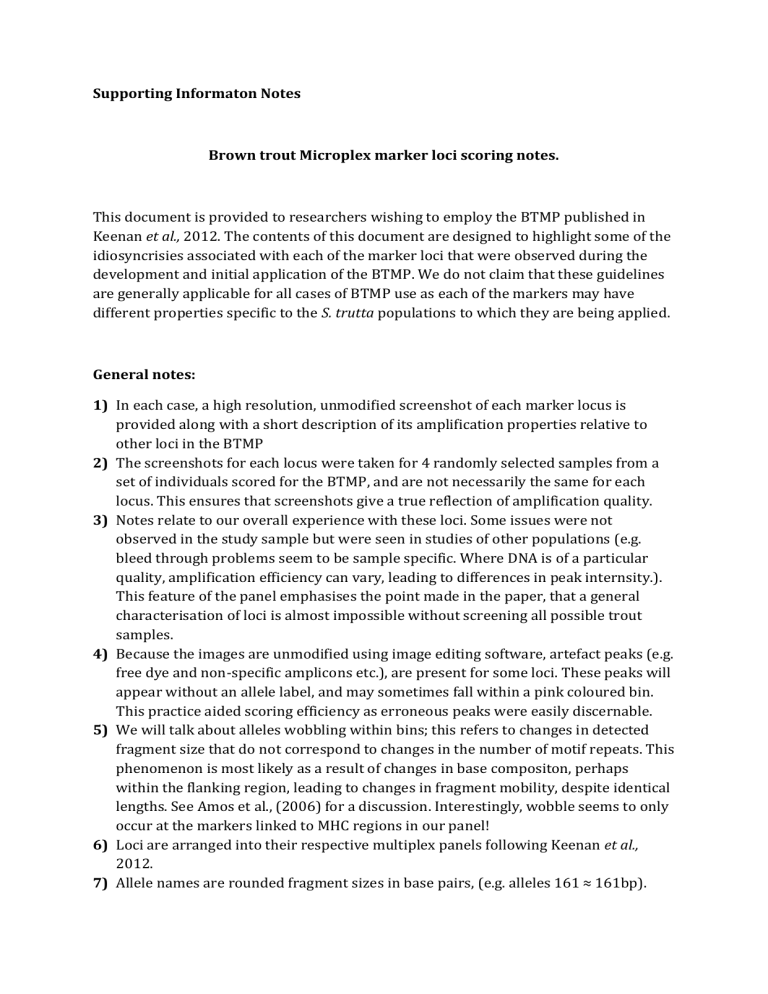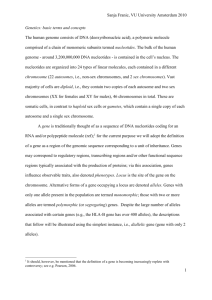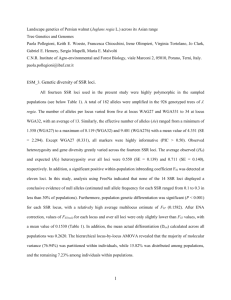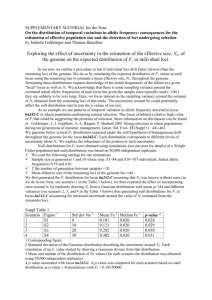jfb12095-sup-0003-AppendixS1

Supporting Informaton Notes
Brown trout Microplex marker loci scoring notes.
This document is provided to researchers wishing to employ the BTMP published in
Keenan et al., 2012. The contents of this document are designed to highlight some of the idiosyncrisies associated with each of the marker loci that were observed during the development and initial application of the BTMP. We do not claim that these guidelines are generally applicable for all cases of BTMP use as each of the markers may have different properties specific to the S. trutta populations to which they are being applied.
General notes:
1) In each case, a high resolution, unmodified screenshot of each marker locus is provided along with a short description of its amplification properties relative to other loci in the BTMP
2) The screenshots for each locus were taken for 4 randomly selected samples from a set of individuals scored for the BTMP, and are not necessarily the same for each locus. This ensures that screenshots give a true reflection of amplification quality.
3) Notes relate to our overall experience with these loci. Some issues were not observed in the study sample but were seen in studies of other populations (e.g. bleed through problems seem to be sample specific. Where DNA is of a particular quality, amplification efficiency can vary, leading to differences in peak internsity.).
This feature of the panel emphasises the point made in the paper, that a general characterisation of loci is almost impossible without screening all possible trout samples.
4) Because the images are unmodified using image editing software, artefact peaks (e.g. free dye and non-specific amplicons etc.), are present for some loci. These peaks will appear without an allele label, and may sometimes fall within a pink coloured bin.
This practice aided scoring efficiency as erroneous peaks were easily discernable.
5) We will talk about alleles wobbling within bins; this refers to changes in detected fragment size that do not correspond to changes in the number of motif repeats. This phenomenon is most likely as a result of changes in base compositon, perhaps within the flanking region, leading to changes in fragment mobility, despite identical lengths. See Amos et al., (2006) for a discussion. Interestingly, wobble seems to only occur at the markers linked to MHC regions in our panel!
6) Loci are arranged into their respective multiplex panels following Keenan et al.,
2012.
7) Allele names are rounded fragment sizes in base pairs, (e.g. alleles 161 ≈ 161bp).
8) Any caveats outlined for the loci of the BTMP are easily overcome with some scoring practice. Although these difficulties add extra time to the scoring process, this is in general only an initial cost as once allele bins are established, scoring becomes virtually automated but for the lowest quality samples.
Ssa85
Ssa85 is an extremely easily scored locus. Alleles occur, in general, every two base pairs.
mOne102a
The first of the co-amplifying loci with the One102 primer set. The stutter pattern of the
166 allele looks in some cases like a distinct allele but its small size relative to the actual allele is inconsistent with this. We have also observed heterozygotes for the 167 and
170 alleles with a similarly large stutter peak, again suggesting that this peak is not an allele.
mOne102b
This is the larger and more polymorphic of the two loci amplified by the One102 primer set. The uniform occurrence of alleles every four base pairs makes scoring very easy.
The only idiosyncrasy associated with this locus is the variable stutter pattern. For this locus, only one out of the 265 individuals used in Keenan et al., 2012, was unscorable.
Ssa406UoS
The Ssa406UoS locus is very polymorphic and has a relatively large size range. The repeat pattern is variable making bin setting difficult. In addition to variable repeat pattern, the larger allele fragment in heterozygotes is markedly less intense than the smaller fragment. The stutter pattern of these larger alleles makes them particularly easy to recognise however. Amplification success is 98%.
MHC-I
This locus is relatively easy to score, and has a 99% amplification success. The only idiosyncrasies are; 1) the slight wobble in the exact position of allele 145 and 2) The weak amplification of allele 131 (shown in pink). Providing the allele bin for this allele is set sufficiently wide enough, this should not cause any problems.
CA048302
The stutter pattern of this locus is consistent with the repeat pattern, however the allele peak is always dominant and thus scoring is relatively easy.
Ssa419UoS
This locus amplifies relatively reliably (98%). The larger alleles peaks observed between 400bp and 560bp tend to be of less intensity than smaller fragments. Another issue with this locus is that CA048828 bleeds through in the lower end of the locus.
There is also an artefact peak at 403bp; this causes no issues during scoring.
Ssa416UoS
The large and uniform size differences between alleles makes scoring this locus foolproof. The dominance of the allele peak and stutter peak at allele 140 can vary and in some cases are equivalent heights. Wide bins which encompass both peaks overcome this issue.
Sssp2201
At first glance this locus seem quite complex. Initial bin setting can be difficult; however, subsequent scoring is relatively easy. The stutter pattern is variable and it is very polymorphic with 44 alleles observed in the 265 individuals screened in Keenan et al.,
2012. An artefact peak is sometimes observed at 265bp, but has a very different peak shape to actual alleles.
Cocl-lav-4
Alleles at this locus have a distinct stutter pattern, making alleles easy to recognise. Its range overlaps with, sometimes, quite strong bleed-through from locus mOne102a on the NED channel. This does not cause issue as the profiles of these peaks are easy to tell apart.
CA048828
There is subset of allele at this locus (between 270bp and 290bp), which occur only 1bp apart. This can make scoring difficult. With the establishment of robust bins however, scoring becomes easy.
Oneμ9
This locus is easily scored. Bins are generally uniformly spaced 2bp apart.
SsaD157
SsaD157 is a particularly polymorphic locus. Its uniform repeat patter for most of its range makes it easy to score.
Sssp2216
This locus is extremely easy to score, but has an unfortunately placed artefact peak within the 134 allele bin. The presence of an allele in this bin can be easily detected as the shape of the artefact peak is altered and the height ratio is adjusted.
Str2QUB
This locus is very polymorphic and some alleles are spaced only 1bp apart making scoring difficult initially. The uniform stutter pattern however, makes alleles readily identifiable.
Str3QUB
This locus is particularly easy to score given the large spacing between alleles. There are small artefact peaks seen along its range, but these do not impede scoring.
Ssa420UoS
This locus is very straightforward to score. It has a relatively low amplification success at 96%. This is likely due to its sensitivity to slight variation in template DNA concentration. Some artefact peaks can also be seen along its range.
mOne104
This locus is very easily scored.
Ssa197
The uniform spacing of allele bins makes this locus easy to score. For weaker samples, a
‘free dye’ artefact peak that overlaps with the 154 allele bin has the potential to obscure alleles falling within this bin, this was not observed in any sample used in Keenan et al.,
2012 however.
mOki10
This locus is very easy to score. The pink ‘bin shadows’ shown above, correspond to an artefact peak that was observed when amplifying this locus using an earlier version of the labelled primer. The primer batch used to amplify the locus for Keenan et al., 2012, did not seem to suffer from this issue.
BG935488
Uniform allele spacing and simple allele peak profile makes this locus fool-proof. There is a strangely shaped peak in the samples presented here; which is likely to be ‘free dye’ associated with the particular batch of primer used.
SsaD71
This locus is very easy to score.
Sasa-TAP2A
This locus is easy to score when initial bins, (which can be difficult to establish), are set.
Alleles seem to ‘wobble’ outside of bins in an unpredictable manner. This suggests that sequence variation may be leading to fragment mobility differences.
CA053293
This locus is very easily scored. The only issue arises from bleed through from locus
CA060208 on the VIC channel most frequently at 161bp.
Ssa410UoS
This locus amplifies weakly relative to the other loci within BTMP-group-3. For this reason, some artefact and noise peaks are present in particularly weak samples. Its relative weakness also results in a relatively low amplification success at 95%.
Nonetheless, this locus is particularly informative. An artefact peak at 197bp is also present in sample samples.
Ssa422UoS
The repeat pattern of this locus does not seem to be uniform; this can make scoring initially difficult. Amplification reliability is high at 98%.
CA060208
The alleles at this locus occur at both 2bp and 4bp apart. Individual alleles can always be distinguished. A ‘free dye’ peak around 180bp may cause problems for alleles observed in this range (N.B. none were observed in Keenan et al., 2012).
MHC-I-UTR
This locus has a particularly complex allele pattern. Most alleles are observed in the lower part of the locus range. However, three distinct alleles are observed almost 150bp away from the largest of the alleles observed in the lower part of the range. Smaller allele fragments also ‘wobble’ within bins meaning that manual bin setting can be challenging. Auto-binning in GeneMapper seems to work well for this locus.
SsaD170
This locus is very easy to score.
Sasa-UBA
This locus is very easy to score. It has the lowest amplification success and only conformed to HWE expectations in one of the six population samples examined in
Keenan et al., 2012. An artefact peak at 457bp is observed in some instance, but does not occur within a range where alleles have been observed. Smaller alleles also ‘wobble’ making bin setting initially difficult. Auto binning works well in this instance.
Ssa413UoS
This locus is very easily scored despite the occurrence of a large artefact peak at 232bp.
Ssa407UoS
This locus is very easily scored despite the occurrence of noise peaks along its entire range.
SsaD48
This locus is exceptionally polymorphic, with 100 alleles being observed in only 265 individuals screen in Keenan et al., 2012. Due to the density of alleles (many of which occur 1bp apart), scoring can be particularly challenging. With practice accurate scoring is possible. This locus may be better suited to parentage analysis type studies, where smaller numbers of individuals are used. There is also an artefact peak at 458bp.
CA054565a
This is one of the co-amplifying loci for the CA054565 primer set. The one allele observed in Keenan et al., 2012 is easily scored. Although all samples in Keenan et al.,
2012 were monomorphic for a single allele, polymorphism has been observed for other brown trout populations by our research group.
CA054565b
This locus was identified late into the Keenan et al., 2012 study. It co-amplifies with
CA054565a but was much more informative than the original locus in that instance. It does however amplify quite weakly (but reliably) and overlaps with two other loci on the same VIC dye channel.
mOne101
This locus is very easy to score. In the primer batch used to amplify the samples shown above, a significant ‘free dye’ peak is observed at 182bp. This did not impede scoring, and is likely to be a primer batch specific issue as it was not observed in the Keenan et
al, 2012 samples.
CA060177
This locus is very easy to score. There is a slight wobble in the allele position within bin
251 for some samples and as such, the bin must be set widely enough to account for this.
mOne108
This locus can be difficult to score because of some shadow/artefact peaks but is manageable with some practice. In weaker DNA samples, the stutter pattern can make scoring complicated especially where both alleles occur above 445bp. With careful examination, the genotype of such individuals can be confidently resolved.






